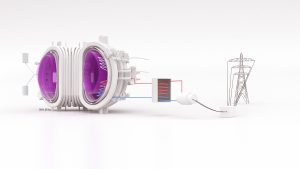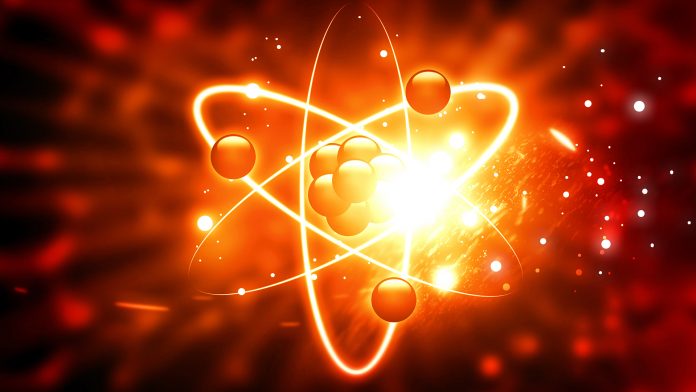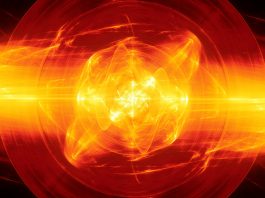Fusion produces clean, sustainable heat and electricity from practically inexhaustible fuel, but who will realise its potential first? Two experts from EUROfusion discuss how public research helps the entire field to get fusion power ready for the grid.
Fusion promises clean energy from widely available fuel – after all, this is the process that powers the stars themselves. However, generating net energy from fusion on Earth has proved a challenge. Private companies now claim they will put fusion power on the grid within a decade.
Sara Moradi, Fusion Expert and Research Coordinator at the public European research consortium EUROfusion, said: “Realising fusion would be one of humanity’s greatest achievements.
“Looking closer at the 17 Sustainable Development Goals of the European Union, it is clear that for most a clean, accessible, and sustainable source of energy would be key.
“Solar and wind will of course play an important role in the future energy mix. However, they cannot provide the required capacity and wide distribution on a global scale and aren’t enough to improve the life of everyone on the planet. Fusion would let us meet that challenge.”


Moradi’s colleague, Richard Kembleton, believes that fusion would make a great addition to the future energy mix, because it complements other sustainable energy sources. At EUROfusion, Kembleton is part of the team designing the future demonstration power plant, DEMO, and has worked on predictions of how fusion would fit into the future energy system.
Kembleton said: “If you try to build an energy system on wind and solar alone, you need to install a huge overcapacity and storage for quiet days. We avoid that now because we have baseload power plants using coal and gas. If we add fusion to wind and solar, we will need less overcapacity and less energy storage. Fusion lowers the cost of the entire system, even if its electricity costs more than that from wind and solar.”

With prospects like that, it is no wonder that private investments in fusion have taken off. In 2022, the Fusion Industry Association (FIA) estimated that the total investment in private fusion companies has grown to $4.7bn. Meanwhile, government-funded labs, both more mature and more cautious in their approach, have set energy records that show they can actually produce fusion reactions in their tokamak devices. But the reality is that, for all the progress, public and private, fusion energy is still in the development stage.
How does fusion work and when will we get it on the grid?
Our Sun has been drawing power from fusion for 4.5 billion years, with 4.5 more yet to go. For a physicist, ultimately most forms of energy come down to fusion. It not only produces light for solar panels, but the energy from sunlight also drives the wind and waves, and lets plants grow to turn into fossil fuels over millions of years.
Fusion researchers try to create the hottest place in the Solar System by heating their fuel to a blistering 150 million °C. At those temperatures, light atoms like hydrogen hit each other so hard they can snap together to turn into heavier atoms like helium with a flash of heat and fast neutron particles – and no greenhouse gas emissions. By catching the hot fusion fuel in a cage of magnetic fields, you can have your artificial star burn as it floats in the middle of the machine. Meanwhile, the uncharged neutrons escape as heat that a generator can turn into electricity.
Fusion is a nuclear process like fission, but creates much less shorter-lived radioactive products because it produces stable helium atoms instead of splitting uranium into unstable fragments. Fusion power plants will use a mix of heavier variants of the hydrogen gas that fuels our Sun, to make for more energetic collisions. The required deuterium occurs naturally in seawater, while its heavier brother, tritium, will need to be created at the fusion plant from the widely available metal lithium.
The most popular and developed fusion device is the tokamak – a donut-shaped machine that levitates a ring of fusing hydrogen using powerful magnets. This workhorse of fusion is the design behind about 50 setups now operating worldwide. Those include the current fusion record holder, Joint European Torus (JET) in the UK, and future projects like the international ITER project and the European demonstration power plant, DEMO. But designing fusion devices that generate net energy can be challenging.

Challenges facing the adoption of fusion energy
“Fusion has a bootstrapping problem,” agreed Kembleton.
EUROfusion aims for DEMO to be the first to demonstrate all the necessary technology to generate electricity from fusion. That technology includes anything from materials that can stand up to punishing conditions, to heating systems, fuel breeding and ways of shaping and controlling the unruly fuel.
“Part of the issue is that you need a working facility like DEMO to test some of the technology,” explained Kembleton. For example, the breeding blankets that will produce part of the fuel on-site, by bombarding lithium with the neutron particles that transfer 80% of the energy from the fusion reaction.
“You need a steady neutron source of the right energy – a working fusion reactor – to check that the designs will work under practical conditions.” EUROfusion aims to address this challenge with smaller experimental facilities that test technologies in isolation.
Kembleton thinks that DEMO will not be a perfect model for a commercial power plant, but will function more as a testbed where all the necessary technologies can be integrated in a working device.
EUROfusion can’t cut its DEMO design too close. Kembleton said: “We have to make conservative choices and show that each of them works through testing and research.”

That means designing the tokamak with enough operational margins so that researchers can be sure it will work. It makes for a slow, methodical approach where there is a research line for every last component. Not everyone is content to wait.
Aggressive approach to fusion research
Impatient with the public research, private fusion companies aim to bring down costs and deliver fusion energy well before DEMO. Some even promise to produce net power this decade, taking potentially game-changing ideas and developing them as fast as they can. It makes for spectacular designs, from squeezing fusion fuel within a mantle of molten metal until it ignites, or using high-temperature superconducting magnets for more compact, affordable machines.
In past years, fusion researchers dismissed such claims of faster, smaller, cheaper fusion power plants. A lesson learned from over-enthusiastic claims in their early days and discovering the myriad ways that hot fusion fuel tries to escape its magnetic bonds. But times are changing.
“Many of these projects are run by people from the field of fusion itself – they know what they’re doing,” said Moradi. Trained on the European tokamak JET and co-ordinating fusion experiments there and at similar facilities across Europe, she sees the diversifying field as a strength.
Moradi continued: “Even in the public programme, we’d like increased funding to explore different options. If someone in the private sector develops improved technology for fusion, that will benefit everyone because they can license it. And even if one design does not work out because they run into challenges, everyone can learn from that attempt.”
Record-breaking research
One recent achievement shows how the public approach is coming along. At the Joint European Torus facility near Oxford, EUROfusion researchers announced a world fusion energy record in February 2022. An attention-grabber, it came as part of a series of experiments to study fusion under the conditions expected in ITER and future power plants. JET is the only facility of its kind in the world that can run on the fuel mix planned for those devices and produce large amounts of fusion reactions.
During its five-second pulse on 21 December 2021, JET generated a spectacular 59 megajoules of energy from fusion reactions. That is enough to power 10,000 European households for five seconds, using only 0.17mg of fuel, ten million times less than would be needed in the form of fossil fuels. The result set a new world record for the most fusion energy released in a single shot, more than doubling the previous world record set by JET in 1997.

The new JET record is a taste of what can become a steady-state fusion power plant, but only a taste. JET’s ageing design requires more energy in the form of external heating and electromagnets than it can ever produce from fusion reactions. Only successor research machines like the advanced international fusion project ITER in southern France will produce more heat than needs to be poured in to keep the process going. Still, the record showed the public device as the first in the world that could reach and maintain stable fusion output at nearly industrial scale.

© iStock/YoGinta
Roadmap
Moradi said: “It was really heartwarming to see the JET results come in.
“What’s even better than the record is that this whole series of experiments showed no major issues in our approach – we’re on the right track.”
“We’ve spent years upgrading JET in preparation for these experiments,” recounted the physicist. That allowed the team to test if their experience in running JET with its forgiving carbon wall also worked with the tungsten and beryllium metals that its successor, ITER, will use.
Part of the challenge of fusion consists of developing ways to build up and structure the blazing fusion fuel (or plasma) for an optimal burn. Moradi added: “Once you light the plasma, a zoo of processes comes alive that you have to deal with. The main problem is maintaining high temperatures at the centre of the plasma while keeping the relatively cool to avoid wall material damage.” That means fighting against the second law of thermodynamics, which wants to even out these temperature differences.
Heat transport is not the only issue in achieving stable fusion, explained Moradi. Plasmas in a tokamak are not just neutral gas, but charged particles caught in a cage of magnetic field lines. Turbulence in the plasma can snarl those field lines or set them vibrating, even leading to blobs of plasma breaking free of the cage. “If you don’t respond quickly, they can completely spoil your shot,” she added.
Fusioneers use fast control algorithms to monitor their plasma by spotting growing clumps and instabilities and zapping them with heating systems before they can disrupt the plasma. In JET, that technique worked well enough that the reaction was essentially stable during the entire experiment. This is good news for JET’s planned successors.
Solid knowledge base
Will the comprehensive public DEMO project be the first to produce fusion electricity as an actual power plant, or can eager private companies scoop government scientists? According to Kembleton, private developments are more closely linked to the public work than you would think.
“I don’t believe that anyone has the perfect design yet, including our own programme. At the same time, some of these companies rely on being able to use outside technology in their designs, like the breeding of tritium fuel that we hope to pioneer in DEMO,” said Kembleton.
Public research can create the broad knowledge basis and train the expert community for follow-up projects to build upon, suggested Kembleton, stating: “SpaceX may have revolutionised the space launch industry as a private company, but only after the heavy lifting of publicly-funded R&D in the 1960s and 1970s. And so, if what we develop ends up enabling commercial fusion power plants, I can only call that a success for our work. We all want to see this happen as soon as possible.”
Gieljan de Vries
Communications Officer
EUROfusion
https://www.euro-fusion.org/
https://www.linkedin.com/company/eurofusion/
https://twitter.com/fusionincloseup?lang=en
Please note, this article will also appear in the twelfth edition of our quarterly publication.









